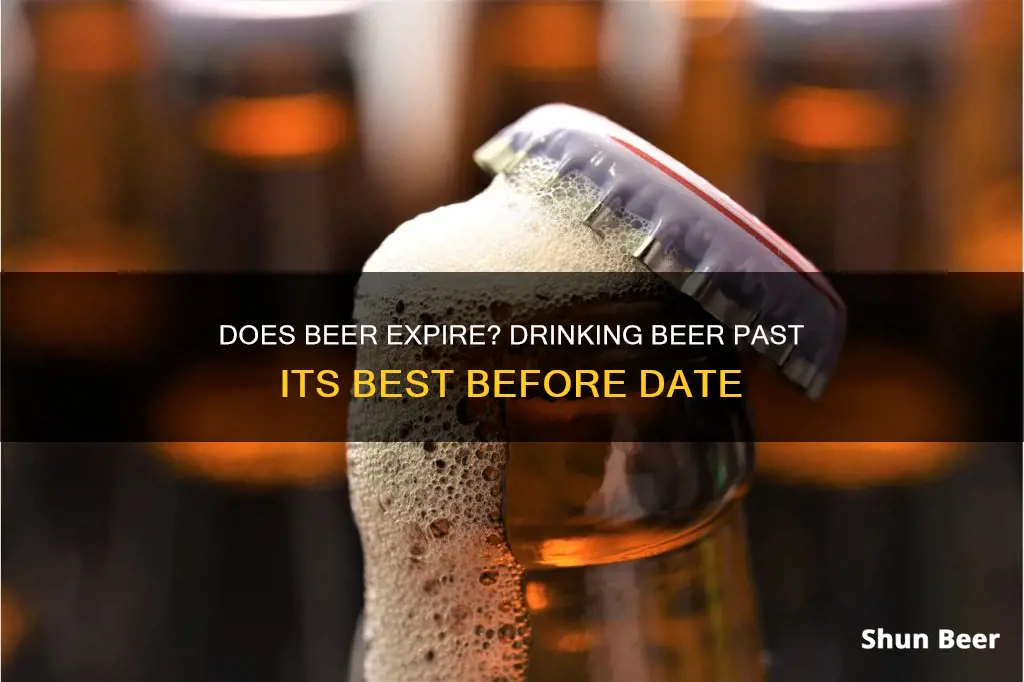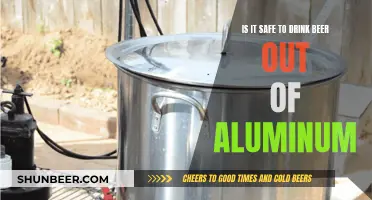
Beer typically has a 'best before' date rather than a 'use by' date, meaning it is safe to drink past the date on the container. The taste of the beer will deteriorate over time and how you store your beer will also affect the taste. Beer is very sensitive to light and dramatic temperature changes, so it should be stored in a cool, dark place. The best test to assess your beer is to use your common sense. Since the beer won't cause you harm, why not try a little bit and see how it tastes to you? If you think it tastes fine, there's no reason not to drink it.
| Characteristics | Values |
|---|---|
| Is beer dangerous to drink after its "best before" date? | No, beer has no use-by date, meaning it is safe to drink well past the best-before date. |
| Will the beer taste different? | Yes, the taste of the beer will deteriorate over time. |
| How long does beer last past its best-before date? | A standard light lager will last around 6 months to 2 years after the best-before date if kept in the fridge and 6–9 months if kept in the cupboard. |
| Will the type of beer affect how long it lasts? | Yes, beers with higher alcohol content such as barley wines, porters, and imperial stouts can taste better over time. |
| How should beer be stored? | Beer should be stored in a cool, dark place to avoid skunking. |
| How can you tell if a beer has gone bad? | Bad aroma, lack of the usual 'pssst' sound, and foaming at the top when opened, or excessive sediment at the bottom of the bottle. |
What You'll Learn

Beer has no 'use by' date
Beer has no use-by date and can be safely consumed well past its best-before date. The best-before date is a guideline on quality rather than safety, indicating that the beer's quality will start to deteriorate after the stated date. However, it is safe to drink and may still taste fine, especially if it has been stored in optimal conditions.
Beer is very sensitive to light and temperature changes. To maintain its quality, it should be stored in a cool, dark place, ideally in a refrigerator or cellar. Fluctuations in temperature and exposure to light can negatively affect the flavour and cause the beer to "skunk".
While the taste of the beer may deteriorate over time, it is unlikely to cause any harm if consumed past its best-before date. The natural combination of alcohol, pH, and antimicrobial properties of hops acts as preservatives, preventing the growth of harmful bacteria.
The length of time beer remains drinkable past its best-before date depends on the type of beer and storage conditions. A standard lager or IPA will typically remain drinkable for 6-24 months after its best-before date if refrigerated, and up to 9 months if stored at room temperature. High-alcohol beers, such as barley wines, porters, and imperial stouts, can age like wine and may even improve with time. These beers can be aged for several years in cool, dark conditions.
Drinking Beer While Nursing: Is It Safe?
You may want to see also

It's safe to drink past the BBD
Drinking beer past its best-before date is safe, but it may not taste as good as a fresh beer. Beer has no "use by" date, and the best-before date is more of a guideline on quality rather than safety. The taste of the beer will gradually change over time, and it will deteriorate, especially if not stored properly. Beer is sensitive to light and temperature changes, so it should be stored in a cool, dark place.
The type of beer also matters. Beers with higher alcohol content, such as imperial stouts and porters, can taste better with age, similar to wine. On the other hand, IPAs and pale ales are best consumed within a shorter time frame, as they will lose their flavour and aroma.
If you're unsure whether your beer has gone bad, use your common sense. Check for a bad aroma, lack of fizz, or excessive sediment at the bottom of the bottle. If it looks and smells like beer, it's probably fine to drink. However, keep in mind that the flavour and quality may not be as good as a fresh beer.
The Amish and Alcohol: A Complex Relationship
You may want to see also

Taste will deteriorate over time
Beer has a 'best before' date, not a 'use by' date, which means it is safe to drink past the date on the container. However, the taste of the beer will deteriorate over time. How you store your beer will also affect its taste. Beer is very sensitive to light and dramatic temperature changes, so it's important to store it in a cool, dark place to avoid it going "skunky".
The rate at which the taste of beer deteriorates depends on the type of beer. A standard light lager will last around 6 months to 2 years after its best before date if kept in the fridge, and 6-9 months if kept in the cupboard. This is also true for a standard IPA or ale. Most beers on the market are best drunk 6-24 months after their best before date.
Some beers are created with ageing in mind, like wine, and can taste better over time. These tend to be high-alcohol beers of around 9% ABV, such as barley wines, porters and imperial stouts. These beers can be aged like wine in cellars or places that emulate cool, dark conditions.
IPAs, on the other hand, do not fit into this category, especially the hoppy ones. They gradually lose their flavour and aroma over time and are best drunk sooner rather than later.
The difference in the above is caused by the organisms that are used in the brewing process. When yeasts are used to produce flavours in speciality beers like lambics and saisons, they change the flavour over time, living in the beer for years, consuming sugar and oxygen to ferment its ingredients.
Enjoying Beer at the Beach: Is It Allowed?
You may want to see also

How you store beer affects the taste
The way you store your beer can have a significant impact on its taste. Here are some key factors to consider:
Temperature
Storing beer at the right temperature is crucial for preserving its intended flavour. Beer stored at higher temperatures will spoil faster and may develop unpleasant "off" flavours. The ideal storage temperature range for most beers is between 2°C and 7°C, with some variations depending on the specific type of beer. Warmer temperatures can cause the breakdown of yeast, contributing to off-flavours, and accelerate the formation of Dimethyl Sulfide, resulting in a cooked corn or vegetable-like taste.
Light Exposure
Beer is sensitive to light, especially sunlight and fluorescent light, which can alter its aroma and flavour. Exposure to light can cause a chemical reaction in the beer, breaking down its flavour components, leading to a skunky or "lightstruck" taste. Dark bottles or cans are recommended as they block more of the damaging wavelengths of light compared to green or clear bottles.
Oxygen Exposure
Overexposure to oxygen can lead to the breakdown of beer's chemicals, altering its taste. Canned beer is less susceptible to oxygen exposure than bottled beer, and storing both types of containers upright can help minimise contact with air.
Time and Freshness
Beer stored at higher temperatures will lose its freshness faster due to increased chemical reactions. The general rule is that beer stored at 100°F for one week will taste as old as beer stored at 40°F for one year. Thus, keeping beer cold helps preserve its freshness and intended flavour for a longer period.
Container and Packaging
The type of container and packaging can also impact the taste of beer during storage. Kegs, cans, bottles, and growlers each have their own storage requirements. For example, larger containers like kegs should be stored away from other foodstuffs to reduce the risk of contamination, and all beer containers should be stored upright rather than on their sides. Additionally, the packaging process itself is crucial, as insufficient care during packaging can lead to increased oxygen exposure, accelerating the staling process.
In summary, storing beer in a cool, dark place, at the optimal temperature range, and in the appropriate container can help preserve its taste and freshness. Improper storage can lead to various undesirable flavour profiles and reduce the quality of the beer.
Beer After a Workout: Good or Bad Idea?
You may want to see also

Beers with higher ABV can improve with age
While most mass-market beers will go off past their best-before date, some beers can improve with age. Beers with a higher alcohol-by-volume (ABV) tend to cellar better, as the alcohol can help prevent oxidization. Beers that emphasise malt, yeast, or other characteristics over hops will also age better, as hoppy flavours tend to fade quickly.
Beers with an ABV of 7-9% have a better chance of ageing well, as the alcohol will help to preserve and improve the flavours and other characteristics of the beer. Beers with active yeast and bacteria, such as sour ales, Belgian ales, imperial stouts, barleywines, strong dark ales, and lambics, are also good candidates for ageing.
However, ageing beer is a risky process, as it can easily result in stale or skunky flavours. Beers should be stored in a dark, well-sealed barrel in a cold, dark room, as UV rays can ruin beer. The ideal storage time is around six months, which will allow for maximum impact on the beer's flavour.
Beer and Stomach Flu: What's Safe to Drink?
You may want to see also
Frequently asked questions
Yes, you can drink beer that's past its best-before date. Beer doesn't have a "use by" date, so it's safe to consume even after the best-before date. However, the taste of the beer will likely deteriorate over time.
The longevity of beer depends on various factors, such as the type of beer, its ingredients, and how it's stored. A standard lager can last around 6 months to 2 years after the best-before date if refrigerated, and 6-9 months at room temperature. High-alcohol beers, such as imperial stouts and porters, can last 5-10 years or more.
Beer should be stored in a cool, dark place, like a basement or cellar, to avoid dramatic temperature changes and exposure to light, which can affect its taste. Refrigeration is ideal, and if the beer was refrigerated when purchased, it should be kept that way. Bottled beer should be stored upright and away from direct sunlight.
Beer that has gone bad will typically have an obvious off-putting aroma. Additionally, a lack of the usual carbonation and foaming when opened, as well as excessive sediment at the bottom of the bottle, can indicate that the beer has turned.







